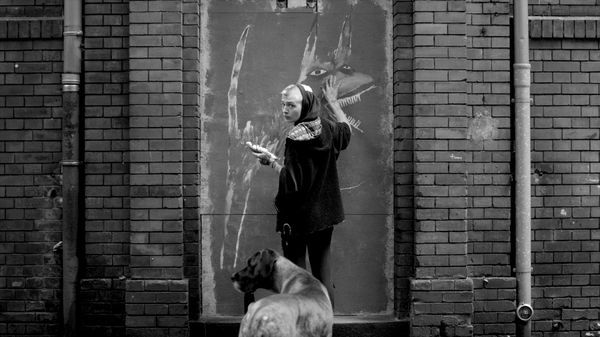Eye For Film >> Movies >> Property (2019) Film Review
Property
Reviewed by: Sunil Chauhan

“Space is a doubt: I constantly have to mark it, to designate it,” says Matthias Lintner in Property, quoting French essayist Georges Perec in his 1974 book Species of Space.
Lintner spent six years living in an apartment building in Berlin occupied by a cross-section of Berliners: elderly residents, who had spent nearly all their lives there but mostly artists and squatters who rejected conventional renting systems to rent cheaply or occupy flats otherwise abandoned. The building Lintner turns his camera on is due for development, a process which doesn’t include keeping its current inhabitants.
Quotes from Perec are sprinkled throughout Property, but while these philosophical digressions cause us to consider notions of ownership, residency, sociable architecture and shared living, Lintner’s footage is idiosyncratic, including everything from the chasing of a rat with a broom, a tiny late night party bathed in red light in one of the flats, to shots of a man shovelling a mattress into a window and a tenant squatting al fresco, over the ground.
Property, which would make a fine pairing on a double bill with Andrea Zimmerma’s Estate: A Reverie, is a casual, offhand look at his fellow tenants and the joys of communal living, or "neighbourship" as he terms it, not an investigation of gentrification. It’s highly interior – most of the film takes place within the courtyard that sits at the centre of the apartment complex where tenants get together, make idle chit-chat, share drinks, cigarettes and film screenings. What do people nearby make of the building’s impending fate or its residents? We never know. Lintner is good at gaining access to his fellow residents, though often assumes the viewer has the same understanding of these people as he does, offering what is a surface-level obso-doc on their interactions.
There is a poetry in these images – an early crane shot which surveys the building and the rubbish left behind by a party in the courtyard shows real skill. But for all the superficial proximity it offers to these soon-to-be-banished residents, it’s the quotes from Perec that grant the film a deeper relevance, asking what makes a home a home, who gets to claim property and who gets to decide what sort of person should live there? The film offers a look at an example of sociable housing where people from all generations and walks of life co-exist, a way of living that is now crumbling in the modern cities of Europe. It questions what cities become when their artistic residents looking for cheap or free rooms are forced out – where do they go? Or do they vanish? Does their work also adjust in line with the priorities of city planners?
Property doesn’t claim to mount a furious investigation of these questions, but as a highly personal, home movie-style ode to one particular example of communal living, Lintner’s film is a casual look into the small talk and tiny gestures that help grease the cogs of social interaction, and the decline of sociable architecture, once designed with that in mind.
Reviewed on: 24 Jun 2019














